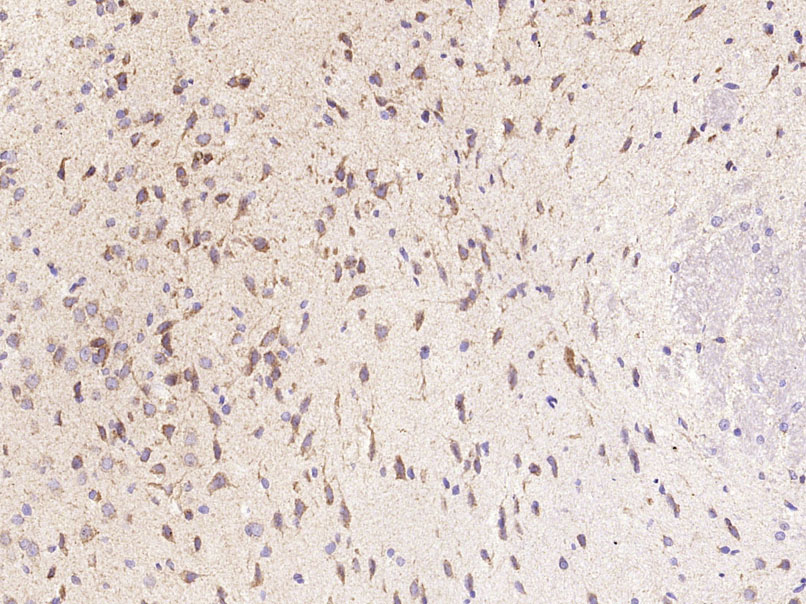
Rabbit Anti-CXCL5 antibody
AMCFII; C-X-C motif chemokine 5; Cxcl5; CXCL5_HUMAN; ENA-78(1-78); ENA-78(9-78); ENA78; Epithelial derived neutrophil activating peptide 78; Epithelial derived neutrophil activating protein 78; Epithelial-derived neutrophil-activating protein 78; GCP2; LI
View History [Clear]
Details
Product Name CXCL5 Chinese Name 上皮中性粒细胞活化肽78抗体 Alias AMCFII; C-X-C motif chemokine 5; Cxcl5; CXCL5_HUMAN; ENA-78(1-78); ENA-78(9-78); ENA78; Epithelial derived neutrophil activating peptide 78; Epithelial derived neutrophil activating protein 78; Epithelial-derived neutrophil-activating protein 78; GCP2; LIX; Neutrophil activating peptide ENA 78; Neutrophil-activating peptide ENA-78; SCYB5; Scyb6; Small inducible cytokine B5; Small inducible cytokine subfamily B member 5; Small-inducible cytokine B5. literatures Research Area immunology Growth factors and hormones Immunogen Species Rabbit Clonality Polyclonal React Species Rat, (predicted: Mouse, ) Applications ELISA=1:5000-10000 IHC-P=1:100-500 IHC-F=1:100-500 IF=1:100-500 (Paraffin sections need antigen repair)
not yet tested in other applications.
optimal dilutions/concentrations should be determined by the end user.Theoretical molecular weight 8/9kDa Cellular localization Secretory protein Form Liquid Concentration 1mg/ml immunogen KLH conjugated synthetic peptide derived from mouse CXCL5: 51-132/132 Lsotype IgG Purification affinity purified by Protein A Buffer Solution 0.01M TBS(pH7.4) with 1% BSA, 0.03% Proclin300 and 50% Glycerol. Storage Shipped at 4℃. Store at -20 °C for one year. Avoid repeated freeze/thaw cycles. Attention This product as supplied is intended for research use only, not for use in human, therapeutic or diagnostic applications. PubMed PubMed Product Detail The protein encoded by this gene is an inflammatory chemokine that belongs to the CXC chemokine family. This chemokine is produced concomitantly with interleukin-8 (IL8) in response to stimulation with either interleukin-1 (IL1) or tumor necrosis factor-alpha (TNFA). This chemokine is a potent chemotaxin involved in neutrophil activation. [provided by RefSeq].
Function:
May participate in the recruitment of inflammatory cells by injured or infected tissue. GCP-2(1-78) and, more potent, GCP-2(9-78) attract neutrophils and are involved in neutrophil activation.
Subcellular Location:
Secreted.
Post-translational modifications:
GCP-2(1-78) and GCP-2(9-78) are produced by proteolytic cleavage after secretion from fibroblasts and epithelial cells. GCP-2(9-78) is the most prominent form. A number of additional N-terminal (processed between pos. 41 and 48) and C-terminal (processed between pos. 118 and 132) processed forms have been identified, probably also representing intermediate states.
Similarity:
Belongs to the intercrine alpha (chemokine CxC) family.
SWISS:
P50228
Gene ID:
20311
Database links:
Entrez Gene: 6374 Human
Entrez Gene: 20311 Mouse
Omim: 600324 Human
SwissProt: P42830 Human
SwissProt: P50228 Mouse
Unigene: 89714 Human
Unigene: 4660 Mouse
Product Picture
References (0)
No References
Bought notes(bought amounts latest0)
No one bought this product
User Comment(Total0User Comment Num)
- No comment



 +86 571 56623320
+86 571 56623320
 +86 18668110335
+86 18668110335

